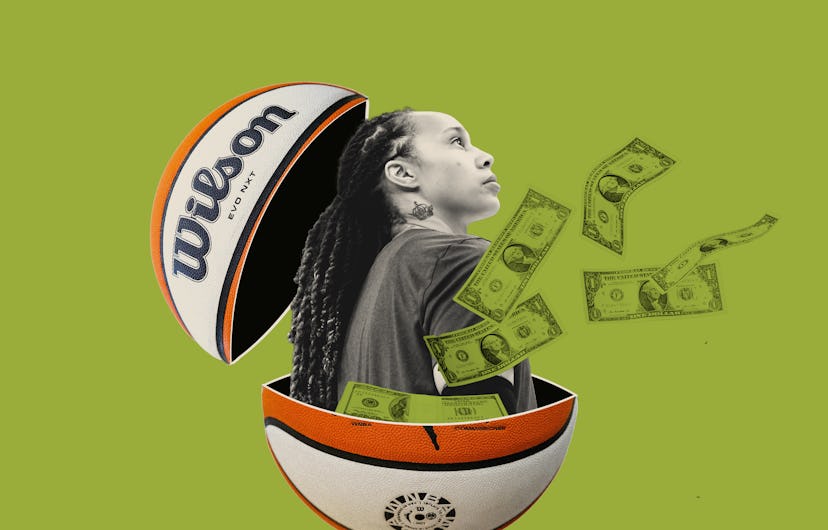Hoop City
Brittney Griner Is Back. Her Detainment Could Change The WNBA Forever.
The Phoenix Mercury returns for its first preseason game, forcing the issue of player salaries back into the spotlight.

It says a lot about the state of women’s sports that it took a 10-month-long detainment in a Russian prison for the world to learn Brittney Griner’s name. She’s one of those once-in-a-generation athletes with a resume so impressive — a frequent WNBA All-Star, two-time Olympic gold medalist, and WNBA champion — and a game so entertaining that she’s earned living legend status among her peers. But as a woman athlete in a league that suffers from drastically less investment and media coverage than its male counterpart, she wasn’t a household name until news broke in February 2022 that she’d been detained.
On May 8, Griner will return to the court when her team’s 2023 WNBA preseason begins, roughly five months after she finally arrived home in December. The ripple effects of her detainment are still spreading through the WNBA, forcing the issue of player salaries into the spotlight and turbo-charging conversations on how to address the low compensation.
“The question that I got the most was not about her wrongful detainment — it was why was she over there in the first place?” Nneka Ogwumike, president of the WNBA players union, tells Bustle. “And that of course brings it down to what this is really about — pay equity.”
The biggest stars in the WNBA make just a fraction of what NBA stars make — the NBA’s highest paid player, Steph Curry, brought home a $48 million salary for the 2022-2023 season, while the WNBA’s top earners made about $228,000. To boost their income, many WNBA players sign off-season contracts with high-paying overseas teams in countries like China, Turkey, and Russia, some of which are funded by governments or oligarchs and can pay athletes seven figures.
Even under the best of circumstances, this off-season arrangement isn’t ideal: Competing at a professional level year-round puts athletes at a greater risk of injury; they often miss out on sponsorship opportunities here at home; and because seasons don’t always align perfectly, the league’s top stars sometimes miss part of the WNBA season.
Athletes have to weigh these risks against the potential paycheck offered by foreign leagues, Ogwumike says. “The majority of players don’t have super big contracts overseas or in the WNBA,” she adds. “They’re doing whatever they can to get as much money as possible to make a living that reflects their value.”
For the 2023 season, Griner will earn just $165,100. When she was arrested, she was returning to Russia to play with her then-team, UMMC Ekaterinburg. “Now we have a high-stakes example of how economic disparity can have terrifying consequences,” Griner’s longtime agent, Lindsay Kagawa Colas, wrote in an op-ed for the Los Angeles Times in April 2022.
Griner’s wrongful detainment and the player-led #WeAreBG movement to bring her home tipped the scales. “It brought visibility to the WNBA at a time when interest [in women’s basketball] was already surging,” Colas tells Bustle. “Media, sponsorships, merchandise, and ticketing have all spiked around BG’s return. Her detention was an ‘aha’ moment. It’s the visibility and accessibility that [the league] has been missing.”
Making it financially feasible for players to stay home year-round has been a priority of Cathy Engelbert’s since she became WNBA commissioner in 2019. In 2022, the league announced it had raised $75 million (the largest-ever capital raise in women’s sports) to help fuel the league’s growth — and eventually baller-level salaries for its players.
“I never thought I would say that I’m so excited to play against Brittney.”
In the meantime, Engelbert launched a new way for athletes to make money in the off-season: as paid brand ambassadors for the WNBA. The program, created as part of the 2020 collective bargaining agreement between the players union and the league, was designed as a win-win: The selected athletes have the opportunity to earn up to $250,000 at home in the off-season by promoting the WNBA in a series of marketing campaigns and appearances. (It’s significantly less than many players make overseas, and some have turned down the offer.)
This year the WNBA is “really blowing it out,” Engelbert says, and will reportedly spend $1.5 million funding the current class of 10 ambassadors. While a significant step forward, the relatively small class size means the opportunity is, for now, available to less than 10% of the league’s 144 players.
“There’s a huge advantage of keeping the conversation on the players during the off-season. I had an executive from a media company come up to me at the NBA All-Star Weekend and say, ‘I’m seeing this player everywhere,’” Engelbert tells Bustle. “That’s exactly what we wanted.” Her goal is to build household names — and if you build it, she says, more sponsor checks and salaries big enough to sustain players year round will come.
When the 2023 season kicks off in earnest on May 19, Griner will return to the court when the Phoenix Mercury take on Ogwumike and the L.A. Sparks. “I never thought I would say that I’m so excited to play against Brittney,” Ogwumike says, laughing. “I’m looking forward to giving her a big warm welcome back.”